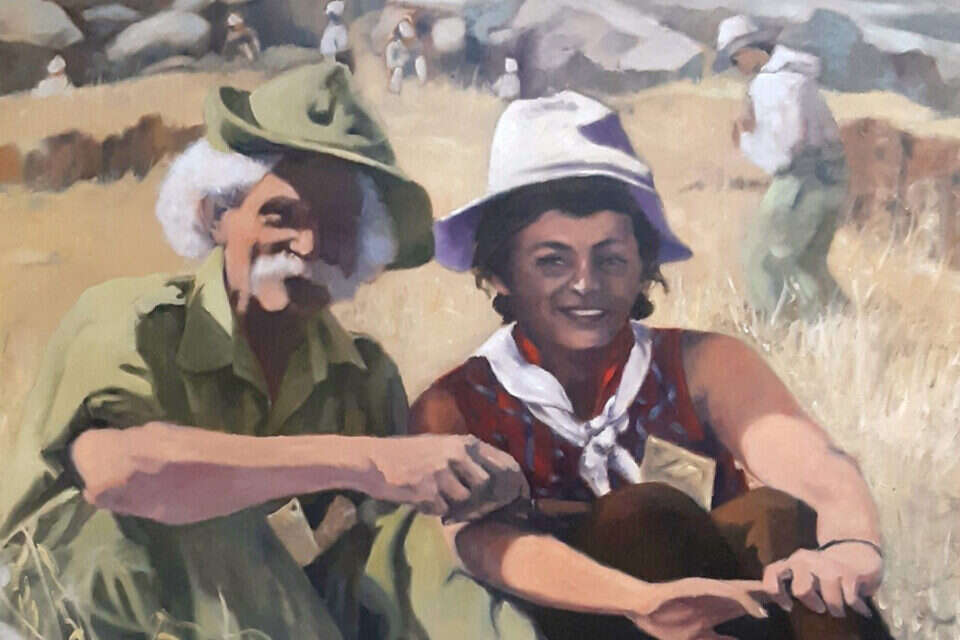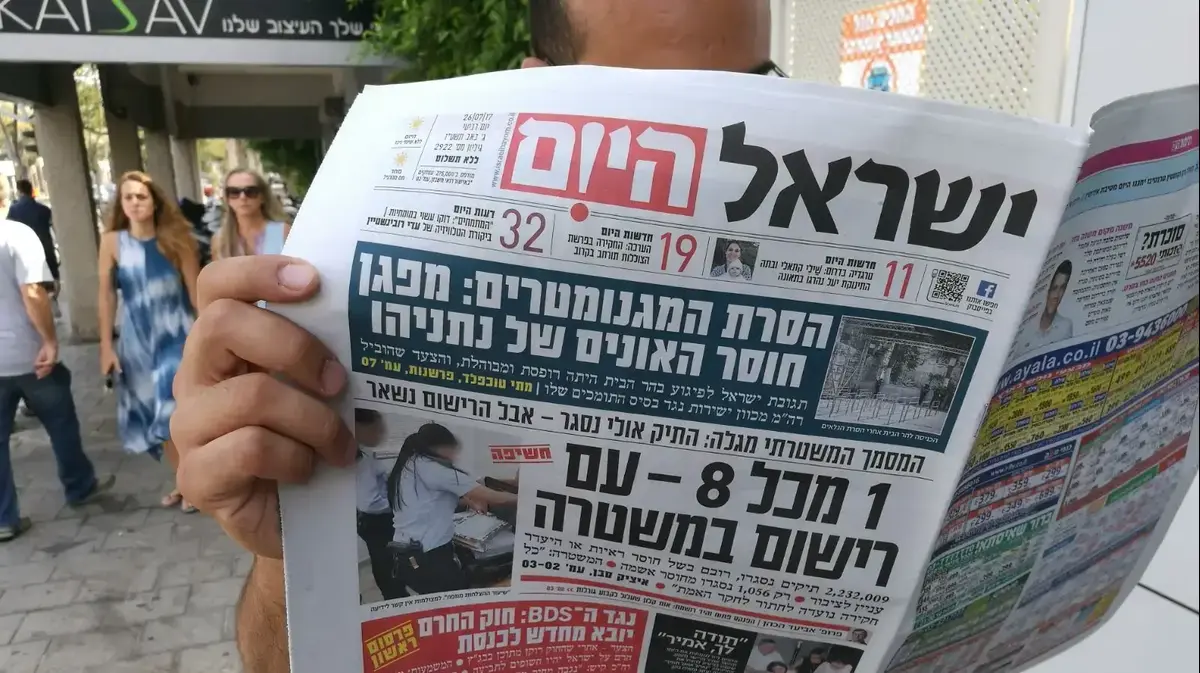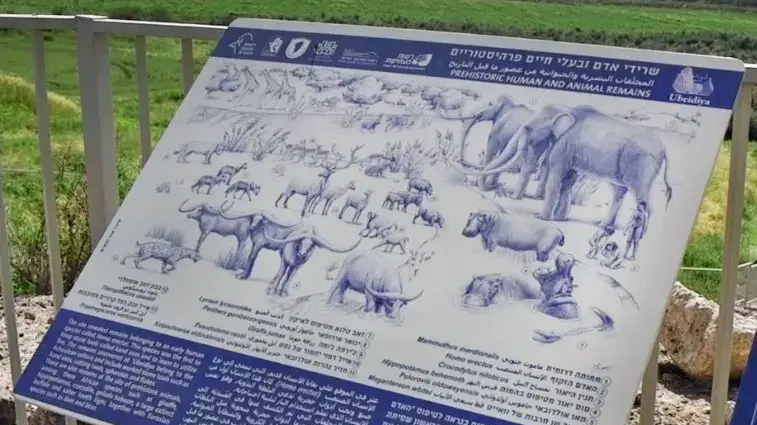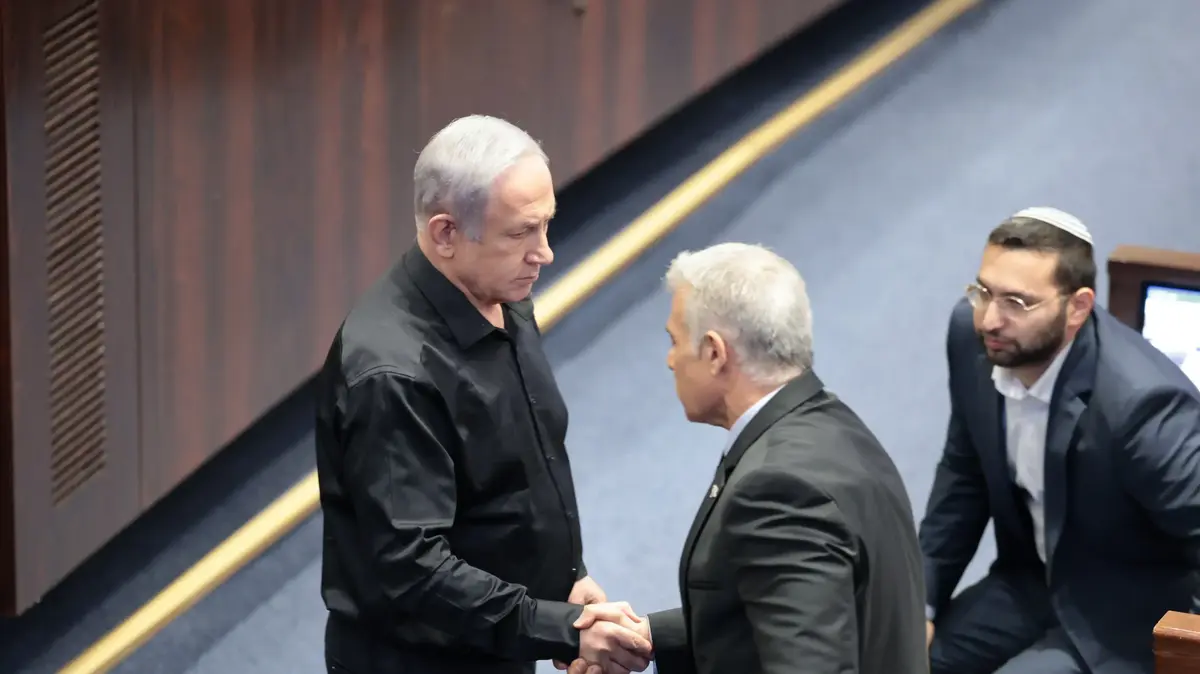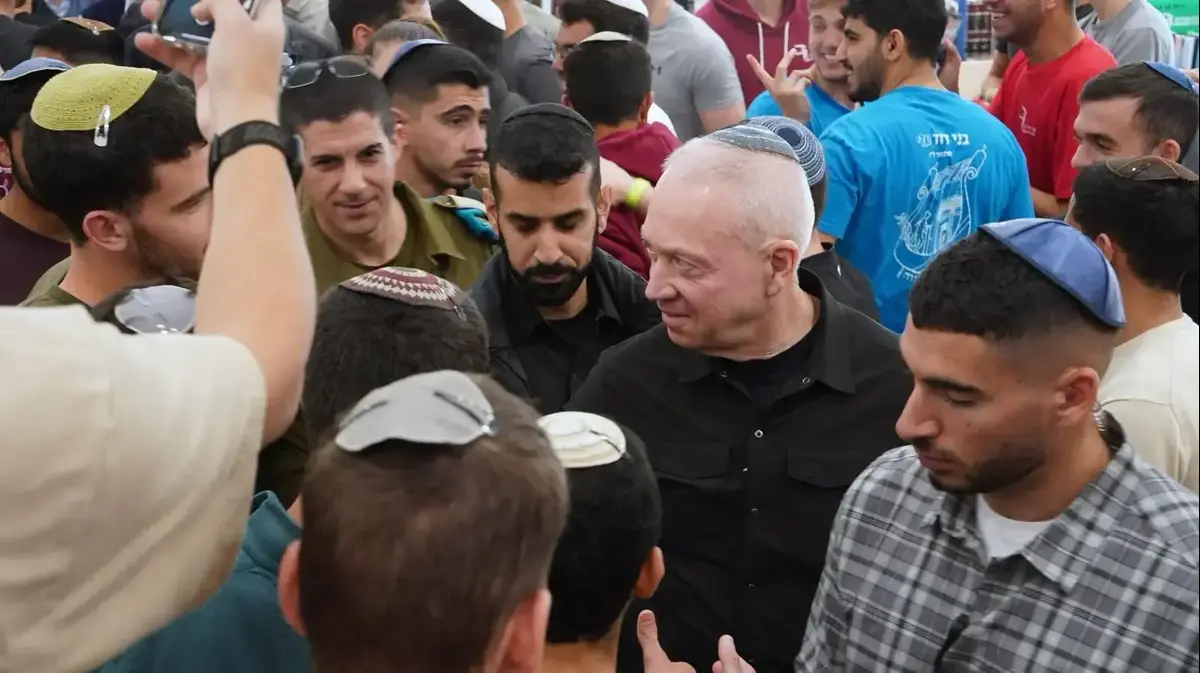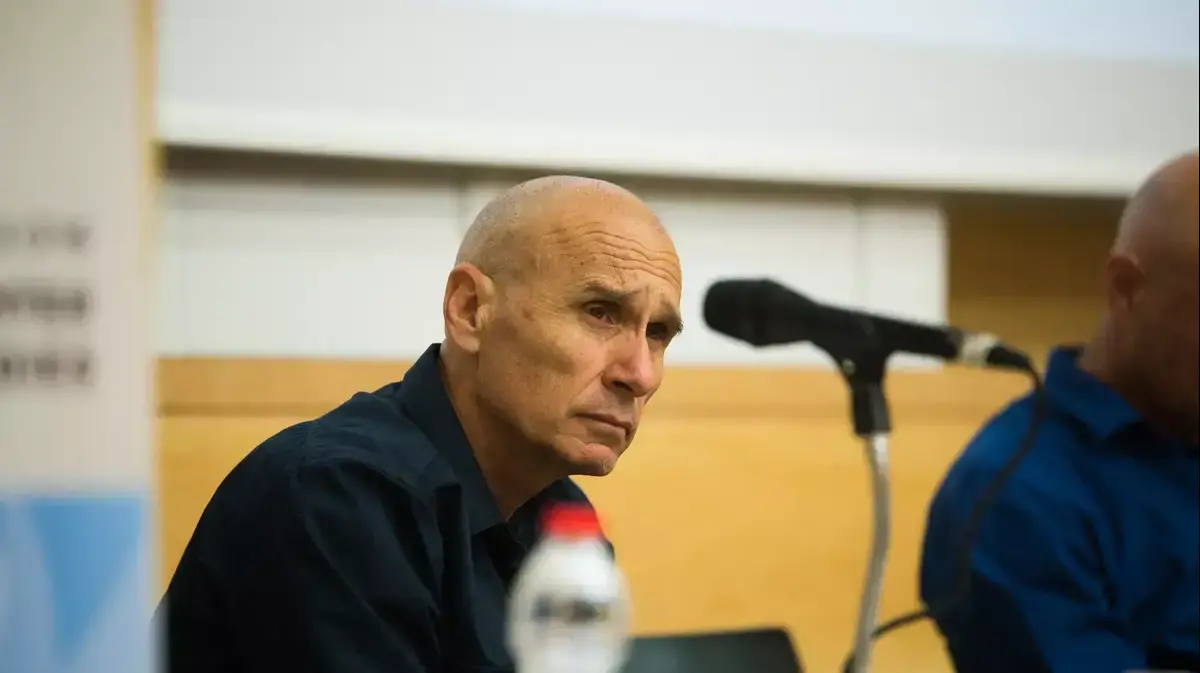In the kibbutz, in the village, in Keret" - Dorot sang Ehud Manor's words to the opening song of "That's it!" Everyone knew what a kibbutz was, villages were in every children's fairy tale, and the challenge of Keret remained the province of the sharp-eared, who knew how to decipher what things were supposed to be about. "But what about the seat?" I asked my aunt Ayala, the moshavnik, "Why aren't you mentioned at the beginning of 'That's it!'?"
"That's how it is in Israel," she sighed, "even if you do everything necessary but don't shout 'shoponi,' they forget you."
For the generation that did not know a world without a screen, we should recall that before it became the festival of cheesecake, and newspaper supplements were filled with gazebos about Provence for the provincials, Shavuot was marked in the Israeli life cycle as the holiday of ceremonies. A holiday of firstfruits and well-publicized visits to the inheritance of the founding fathers and the originating mothers - the kibbutzim.
True, no state is established solely by sickle and sword pioneers – you need doctors, bankers, cooks and plumbers, but ten cabins of credits for the establishment of the state fell from the sky, nine of which were taken by the kibbutzim, either by choice or by force.
Zionism sought to create a new kind of Jew in the Hebrew land, so who would be the models of light unto the nations? Traders and financiers? Of course not. Cultivating the land? A land of yogbees and vintners? Undoubtedly. But why don't we think of the heroes of the agricultural ethos when we think of the moshavim?
"Wagon with mule" (1960). Daniella Meller, Oil Paints on Canvas, September 2018,
Exactly this question I ask Shlomo Tirosh from Moshav Orbit. He smiles, but without joy.
"First of all, you need to know that there are two types of seats," he replies. "Do you know the young settlement? The concept that today all settlers celebrate? They actually took this from the Moshavim movement. There, too, there is an old and young settlement.
"The veteran settlement is all those who came to the ground before the establishment of the state. Workers' moshavim and cooperative moshavim such as Nahalal or Kfar Yehezkel, which were like the kibbutzim in terms of origin and composition. They had common tools, but unlike the kibbutz, each family managed financially as a separate unit. After the establishment of the State of Israel, the 'Young Settlement' appears, moshavim most of which are outside the Hadera-Gedera border."
These became known as the "immigrant seats."
"Indeed. Most of the moshavim after the establishment of the state were populated mainly by Romanians and Mizrahim."
And it was the young settlement that lowered the prestige of the moshavniks relative to the kibbutzniks?
"That's what you said."
Daniella Meller: "In the discourse that developed among the visitors to the exhibition, I understood that I was actually telling the story of the pioneers from North Africa, which is not mentioned, in my humble opinion, in Israeli art. I also realized that my family story is actually a completely universal story."
"On the first I leave"
In order to reach the time and place where we meet, Tirosh had to go through a life journey that placed him at the center of the Zionist enterprise. His father, Eliyahu Zaga, was one of the first recruits to the Palmach's Arab Division established by Yigal Allon, which was in fact the first undercover unit.
As part of his service, Zaga was in Damascus, where he functioned as part of a network for smuggling and bringing Iraqi and Syrian Jews to Israel. At the same time, he served as a spy for the SJ and conveyed messages about the Vichy regime that ruled Syria at the time.
At that time he met Jamila, a native of Damascus, and the two married. Shlomo was born in Damascus in 1944, and in 1948 the Syrian secret police surpassed his father. Since they were only able to prove his Zionist activity, he was sentenced to a year in prison, after which he escaped with his family in a fishing boat from the port of Beirut to the port of Haifa. IDF forces fired at them when they arrived, but luckily managed to reach the shore unharmed. The soldiers put them in jail, until Yigal Allon arrived himself to free the spy who had returned from the Syrian frost.
"From there we moved to an apartment of discharged soldiers in the Borochov neighborhood of Ramat Gan, 38 square meters. Father, mother, two other brothers and sister," Tirosh recalls. "When I was 10 years old, my mother died, and today I can say that my father was suffering from post-traumatic stress disorder from a Syrian prison.
"He sent me to Bnei Akiva's boarding school in Kfar Haroeh, so that I could say Kaddish for my mother there. When the year ended, I joined my brothers and sisters in an anonymous institution in Kfar Saba, where the principal was Polish, the teachers Polish, and worst of all, the food Polish. But the manager turned on me and let me cultivate the vegetable garden.
"From there I continued to the youth society at Kibbutz Galil Yam and fell in love with farming. By the way, speaking of kibbutzim, I want to tell you that the whole group that was with me in Galilee Yam is full of praise and gratitude for what we received there. We didn't even feel where and where between the kibbutz children from the parallel class and between us – the children of the youth society."
So why didn't you stay on the kibbutz?
"After the army I had a crisis. They let me run a new branch on the kibbutz, pepper for export. We grew 40 dunams of pepper in the tunnels, with a kind of nylon cover that we would open every morning and close in the evening. One night that winter there was a strong storm. I was worried, so I went to see what about the pepper, and my eyes darkened. I found that the wind blew all the nylons and the peppers were going to die.
"I went to ask the kibbutz members to come and help me close it again, I knocked on everyone's door and no one wanted to get up! Luckily I thought about going to the teenagers, and that's where everyone got up. We worked all Saturday in pouring rain to cover the plot and saved it.
"The growth was very successful and the business results are very good, so as a thank you I took the youth in the kibbutz's Volvo truck to the 'My Fair Lady' show at the Alhambra in Jaffa.
"At the end of the growth, I sat with myself and thought about who am I going to live with - with friends who don't treat the kibbutz as their own? Since I am a man of work, and work was a supreme value in my eyes, that Friday I went to the center of the economy and told him, 'Thank you very much, on Sunday I am leaving.' He was shocked, told me they had decided to enroll me in the Faculty of Agriculture and added, 'You have a future with us,' but on Sunday I was at my father's house in Beersheba. I went to work as a taxi driver."
Esti Tirosh: "People abandoned at night. I was horrified that the seat would be abandoned for good and said, 'We're here.'" Shlomo: "Forget it, the older Jews, Iranian immigrants, welcomed her warmly and she fell in love with the place." Esti: "We were the first couple to come to live in the moshav by choice"
And what about all the love of agriculture?
"I had a vision, to get into the moshav. It cost 4,500 liras and it took me three years to save that amount. My dream and future were agriculture, but I didn't want a kibbutz, I wanted to be responsible for my own farm and not need the favors of others, so I decided to go to a moshav."
How did your family get it?
"No one in the family was a farmer, they were merchants. My grandfather was a merchant, and my uncles owned shops in the HaTikva Market. They bought plots in Gan Yavneh, Holon and Ashdod, and were diligent and orderly, arranging their future generations. I went to agriculture and came to Moshav Netiv in the Negev.
"By the way, my uncles supported me in their way and were very enthusiastic when they came to visit. They even gave me money to buy a tractor from a French company, but I didn't have the money to transport it all the way to the moshav, so I drove a whole day from Haifa to the moshav in the Negev at 30 kilometers per hour."
"We'll call him black"
On his last day on the kibbutz, Shlomo met Esti, who had come to volunteer from Bat Yam. "In the Moshavim movement they told me that in order to get into the moshav I had to be married," he smiles, "so we got married."
"I was still in high school, and when I saw him I was so impressed that I wrote him a letter," Esti says of her version. "Then my parents found a dollar bill that Shlomo had given me with a heart and an arrow, and they said it was like an ethnan. They fought with me so much that I went to live with my literature teacher. Is it any wonder I became a librarian?
"It took a long time before they agreed to get to know Shlomo. My Polish mother, of course, didn't want to accept him, and when Shlomo stood in the doorway, she saw him and said, 'Ancient man.' My brother said, 'We'll call him black'...
"But my father understood that it was impossible to get rid of this leprosy, so he took him for a talk, and in the end everyone saw that he was serious. When I was 17 and a half, we got married, right after my last adulthood. The wedding was on July 31, 1969, and by August 1 we were here in the moshav. This, of course, is also where our three daughters were born."
"The Jewish Agency has already thought about wiping the seat off the map." Shlomo and Esti Tirosh in their home in Moshav Orbit, Photo: David Peretz
Why in the Negev? Why a route?
Shlomo: "In 1951, they put 88 families from Iran in trucks and brought them to the track, a few kilometers west of Ofakim, on the 'Hunger Road.' They were told, 'Please, now be a farmer.' Some say they were thrown out of the trucks.
"The same thing happened in redeemed and safe moshavim with immigrants from Yemen, in Moshav Gilat with immigrants from Tunisia, in Moshav Fetish with the Kurds, and in Moshavim Brosh and Tidhar with the Moroccans. When we arrived, the runway was almost deserted. Only 18 of the original families remain, and the Jewish Agency has already thought about wiping it off the map."
Esti: "Out of shame, people left in the middle of the night. You get up in the morning - and they're gone. I was horrified that the moshav would be abandoned for good, so I told Shlomo, 'We're here.'"
Shlomo continues her remarks as part of a conversation of veteran couples, who speak as if they were a pre-written play. "Forget it, she saw here the older Jews, Iranian immigrants, and how they received her with so much affection and warmth, that she fell in love with them and the place on the spot."
Esti: "We were the first couple to come to live in the moshav by choice."
"By choice," Shlomo repeats, shaking his head and smiling.
Shlomo Tirosh: "In 1951, they put 88 families from Iran in trucks and brought them to a track, near Ofakim, on the 'Hunger Road.' They were told, 'Please, be a farmer.' The same thing happened with immigrants from Yemen, in Gilat with immigrants from Tunisia, and with a hammer with the Kurds."
"Development Seats"
In fact, the "immigrant settlements" were the "development seats" of the working settlements in Israel. When I ask Shlomo if there was a fundamental difference between them and the kibbutzim in the area, he replies: "The conditions were against us. Before the National Water Carrier, each moshavnik received five dunams for cultivation with a line of pipes with shade diameter for irrigation, which it would transport from place to place. It's nothing, water.
"The kibbutzim had tens of thousands of dunams and more water and developed extensive agriculture – wheat, barley, cotton, sorghum. In the moshavim they grew intensive agriculture - vegetables, flowers, orchards and peach groves.
"Another gap was that in the kibbutzim at the time there was an ideology that they did not employ foreign workers, Jewish or non-Jewish, and in these crops everything was mechanization. The kibbutz movement advocated self-employment, and the moshavniks grew agriculture that required the help of outside labor and depended on working hands.
"עד 1967 עבדו כאן בני אופקים, נתיבות ושדרות, אבל אלו לא היו הפרדסים של המושבניקים אלא של הסוכנות, שהעסיקה אותם כעובדים שלה. אחרי 1967 התחילו להגיע פועלים מעזה".
אפשר להרוויח בחקלאות מ־5 דונמים בלבד?ֿ
"עד 1963 היו חמישה דונמים, אבל אז המוביל הארצי נתן יותר מים והמשקים גדלו ל־20 דונם. החקלאות הכי טובה ומקצועית היתה במושבים, אבל ההבדל בין החקלאות הקיבוצית לזו המושבית הוא שבקיבוצים הענפים בנויים על מעט מאוד כוח אדם. הם יכולים להחזיק 20 אלף דונם עם שבעה או שמונה אנשים, ובחקלאות המושבית בשביל עשרה דונמים חממות אתה צריך לפחות עשרה פועלים. ועדיין, למרות הכל, החקלאות המושבית היתה הרבה יותר רווחית וההכנסה פר־דונם וקוב מים היתה הרבה יותר גבוהה".
לא הרגשתם חקלאים סוג ב' ביחס לקיבוצים?
"ממש לא. הקרב על המעמדות היה בתוך המושבים. בין ההתיישבות הוותיקה להתיישבות הצעירה היו קרבות על אמצעי הייצור והמכסות - למשל, כמה אנחנו נקבל לגדל וכמה הם. הקיבוצים חיו את החיים שלהם ואנחנו את שלנו. יותר מזה, צריך לומר גם שהקיבוצים עזרו לנו מאוד".
איך למשל?
"כשבאתי למסלול ידעתי לגדל פלפל ובוטנים, אבל לא ידעתי לגדל תפוחי אדמה, אז הלכתי לשכנים שלנו, ושווייקה מקיבוץ אורים אימץ אותי והראה לי איך לגדל תפוחי אדמה כמו שצריך.
"היתה פה חקלאות יפהפייה, בכל המושבים. בפטיש, בקלחים, בפעמי תש"ז ובתלמי ביל"ו היו חקלאים מעולים. בשנות ה־70 מהרווח השנתי על דונם אחד של חממת פרח הציפורן יכולת לקנות דירה. אנשים עם חמש פרות ומכסה של 1,000 ליטר מים בשנה התפרנסו בכבוד. היום מכסת הייצור המינימלית היא 600 אלף ליטר חלב, ובקושי מתקיימים מזה".
"הירקות שאתה אוכל מתוצרת ישראל כולם ברמת הגידול הכי גבוהה, אבל כשאתה מוותר ומביא מטורקיה בזול - לחקלאי הישראלי אין דרך להתחרות. וחקלאי שעוזב לא חוזר. המדינה עושה טעות אסטרטגית כשהיא לא ממשיכה לפתח את החקלאות"
"החקלאות נודדת"
אולי זו הנקודה לגלות ששלמה אינו עוד מושבניק. הלהט החקלאי שלו, לצד מוסר העבודה הגדול, הובילו אותו לתפקיד מנכ"ל עמותת מגדלי הפרחים בישראל, ומאוחר יותר לכהונה של 13 שנים כמנכ"ל "אגרקסקו", ענקית יצוא התוצרת החקלאית מישראל לעולם, שם ניהל מחזורים של מיליארדי שקלים.
הידע, הניסיון והמבט שלו משתרעים מרמת הרגב באדמת הנגב, דרך מחירי שינוע הוורדים מקניה להולנד, ועד הרגולציה והחקיקה הפוליטית. לכן אין מתאים ממנו לתהות מה בעצם קורה לחקלאות הישראלית.
"בשנות ה־70 מהרווח השנתי על דונם אחד של חממת פרח הציפורן יכולת לקנות דירה. אנשים עם חמש פרות ומכסה של 1,000 ליטר מים בשנה התפרנסו בכבוד. היום מכסת הייצור המינימלית היא 600 אלף ליטר חלב, ובקושי מתקיימים מזה"
"אנחנו נמצאים בעולם שבו ההוצאות גדלות וההכנסה לא גדלה באותו קצב", הוא אומר. "כל ענף הפרחים בארץ, למשל, שהגיע ליצוא של מיליארד וחצי פרחים עם מחזור של קרוב ל־300 מיליון יורו בשנה, חוסל בגלל עלות כוח האדם שגדלה.
"פעם העבודה היתה זולה, חומרי ההדברה היו זולים ועוד, אבל כל התנאים השתנו מן הקצה אל הקצה. מדינות אחרות בעולם כמו קניה, מרוקו, טורקיה או מצרים, שבהן העבודה זולה, נכנסו חזק מאוד לחקלאות, וזה על חשבוננו. בענף הוורדים, שבו היינו הכי טובים בעולם - יותר מההולנדים אפילו - בקניה פתחו חוות והדיחו אותנו מהשוק.
"גם ענף התמרים היה ענף לתפארת, ואם תלך מדרום הכנרת ועד קיבוץ אילות שליד אילת, כל הבקעה, ים המלח והערבה עדיין מלאים בתמרים, אבל התחילה תחרות חזקה ממרוקו, והיום הם חושבים לעקור את המטעים. יש להם מלאי של שנה וחצי קדימה במקררים. החקלאות נודדת למדינות לא מפותחות ששכר העבודה האנושי בהן נמוך, או שמחיר המים נמוך, או שאין שם שום הקפדה ורגולציה על חומרי ההדברה שמשתמשים בהם.
"כשמייבאים עגבניות מטורקיה ומתחרים עם המגדלים בארץ צריך לזכור שבטורקיה כמעט לא משלמים על מים. אם בארץ יש הקפדה גדולה על גידולים ללא חומרי הדברה, בטורקיה בכלל לא מעניין אותם הנושא הזה, ואז בפועל אי אפשר להתחרות בהם, ולכן המושבים סבלו מאוד. גם ענף הכותנה, למשל, חוסל כמעט לגמרי על ידי חקלאות מצרית זולה, אף שהאיכות שלנו היתה הרבה יותר טובה.
"כמו כן, פיתוח החקלאות לא גדל בקצב מקביל לזה של האוכלוסייה. החקלאות היא נגזרת של קרקע ומים. ליתר דיוק, כמות המים המתוקים שראויים למאכל, לשתייה ולחקלאות נשארת קבועה, אז הכמות לחקלאות מתמעטת יחד עם גידול האוכלוסייה.
"הירקות שאתה אוכל היום מתוצרת ישראל הם כולם ברמת הגידול הכי גבוהה בחממות, אבל כשאתה מוותר ומביא מטורקיה בזול לחקלאי הישראלי - אין דרך להתחרות. וחקלאי שעוזב את הגידולים שלו - לא חוזר".
אבל הייטק הרבה יותר רווחי, וצימרים מכניסים הרבה יותר כסף מעגבניות, לא?
"בעיניי המדינה עושה טעות אסטרטגית בכך שהיא לא ממשיכה לפתח את החקלאות. בחקלאות האינטנסיבית לא צריך הרבה שטחים, צריך ידע".
אבל זה שוק חופשי, וכשאני קונה לאמא שלי עגבניות בסופר ב־7.90 שקלים לקילוגרם היא צועקת עלי שאני בזבזן, שיש עגבניות מטורקיה ב־3 שקלים.
"All the mobilized media, which serves the tycoons, has inflated everyone's heads. People always come to the supermarket to talk about the cost of living, and where do the cameras go? to the vegetable shelf."
Shlomo, who was excited by the last question, pulls out a bag from the cabinet next to him and slices four packages of toothpicks on the table. The price difference is huge: from NIS 5 for a generic package he bought at a pharmacy in Rahat to NIS 20 from a branded chain. The product, by the way, is absolutely identical.
"People are willing to pay 400% more for toothpicks from China, and you're talking about 8 shekels per kilo of tomatoes?!" he continues. "Do you know how much work it takes to produce a kilo of tomatoes versus toothpicks? But that's not what the cameras are looking at. Why?
"In Israel, you look at the cost of living through vegetables, as if it's some kind of 'agricultural cartel.' There are 10,000 farmers in Israel who compete very hard with each other, and when you enter the supermarket you find tomatoes from here and there, but we will see you find a shelf of chocolate or pasta in the supermarket that is not of the big manufacturers and importers. Brainwash Israelis and divert their fire at the farmers, while a few families control almost half of Israel's GNP. They also control the media and the media, raising prices and the cost of living to their greedy heart."
"Preparations for Aliza's wedding" (1969). Daniella Meller, Oil Paints on Canvas, 2021,
Second generation crisis
When he looks back on his life in a moshav on the "Hunger Road" at the edge of the country, Shlomo wonders if he feels like he has fulfilled the agricultural vision of Israeliness, the vision of "the man under our limbs and under his limun."
"When we came here, everything was desert, and today it's a flourishing area," he says. "There is a developed community life here, people are fighting to come, and the vision for me is that as many people as possible will come. Fortunately, I am happy that my self-realization met the national fulfillment of the people and the country."
Later, Esti sends me a video from 1971, produced on behalf of the Moshavi Workers' Movement in Israel as part of the Moshavim Movement's Jubilee Celebrations, documenting their first days in the moshav.
"Esther Zaga is a young colonist," the narrator says as R. rolls, and the camera loves the golden hair of the rose grower in the green greenhouse and ignores her injured hands.
The first few days in a track seat. Esti Tirosh as a young rose grower, photo: from a film of the Moshavim movement in 1971
When Gedalya, a member of the wave of old settlements from Kfar Vitkin, comes to see how the immigrants he guided in the Negev are rising and succeeding. With a beret hat, sunburned face and Omar-Sharifi mustache, we might have mistaken it for Saleh-Shabti-style mockery, but the conversation with him is far away.
After complaints about the scarcity of water that makes it difficult for them to succeed in agriculture, the Moshavniks also emphasize how important their children's education is for them, such as wishing that their children would not continue working the land.
Every ideological movement has a second-generation crisis. The first generation rebels against its parents and formulates its own ways, but what happens when the rebel generation produces a new generation? Will they rebel like their parents, or will they choose to follow the path they deafened? And what happens when the parents' generation itself is not at all sure that this is the right life?
"Where are you going?"
On Friday afternoon, when this question and the conversation with Shlomo and Esti echo in my ears, I arrive at Kibbutz Urim and for the first time notice the variety of tractors and large agricultural tools, most of them green and yellow, parked in huge sheds. But the purpose of the visit is different, to check out an enthusiastic recommendation from a friend and taste "sublime ice cream". At the edge of the kibbutz, between green lawns and agency houses, the new emerges from the old. Table crops with promises of espresso, an orchard of chairs designed as comfort far and wide, and an ice cream parlor unique to Allah called "Galiella".
With flavors like "vanilla peas" or "sweet potato and lemon celery," it seems like someone has confused the field crop industry with the ice cream industry – and the taste surprises far beyond. I am glad that beyond Curiosity, another charming corner for the heart of hunger has been found in the heart of the western Negev. No less important, at Galiella I meet Tehila Cohen from Moshav Fetish and Lia Winkler from Ein HaBasor, both before enlistment, who work there and give me a glimpse into Moshavniki - the next generation.
In your generation, is there another difference between a kibbutz and a moshav?
Glory: "Sure, notice how quiet the kibbutz is! At such an hour, Friday afternoon, my seat is lively. Music from every window, everyone cooking. The kibbutz has such a narrow road and cute little houses, with us everyone builds a house with his own garden and area. Put a moshavnik and a kibbutznik next to each other, you will immediately know the difference."
Lia: "I grew up on a kibbutz, I saw the big guys working in the West Bank, and it seemed impressive to me. Today the heroes are ostensibly the high-tech ones, but in the area I come from, the farmers are the rich, and these are mainly the moshavniks. Whoever has a good farm, you know he's sitting well."
"Put a moshavnik and a kibbutznik next to each other, and you will immediately know the difference." Lia Winkler (right) and Tehila Cohen, photo: David Peretz
And how do the townspeople you meet treat you?
Tehilla: "When the people of the city meet us, they say to me, 'Are you from the moshav? Oh, what a poor thing, you probably don't have money,' while in our guys if you know you have a cowshed they say, 'Wow, that's minced.' In the moshav, whoever owns a cowshed is considered rich. But the worst thing is that the townspeople always ask us the same thing."
What?
They both laugh: "Where are you going tonight?"
Lia Winkler: "I grew up on a kibbutz, saw the guys in the West Bank and it looked impressive to me. Today the heroes are ostensibly the high-tech ones, but in my area the farmers are the rich and these are mainly the moshavniks. Whoever has a good farm, you know he's sitting well."
The Vanishing Heroines
As interesting as it is, the question "What would happen if?" is a dead end. The past is past, and the best you can do is frame it as a new or renewed story.
A few years ago, during a visit to a studio in the Old City of Beersheba, I saw the past being reframed, within the frame of Daniel Meller's paintings.
Meller, who was born in Tunisia, came to Israel at the age of 8 in the 50s. Her family lived in the western Negev and development towns, she grew up and became a nurse at Soroka Hospital, and after she retired she began painting according to black-and-white photographs from the family album.
Meller's brush paints the past in a variety of colors of innocence. Ironically, the choice to give innocent, optimistic and smiling black-and-white characters creates a defiance of the depiction of the pioneers and laborers of the kibbutzim versus the people of the moshavim and towns, those who were excluded from the great pioneering story of the Land of Israel.
"36 square meters" (1960). Daniella Meller, Oil Paints on Canvas, November 2016,
"From a dialogue that developed among the many visitors to the exhibition, I understood that I was actually telling the story of the pioneers from North Africa, a story that is not mentioned, in my humble opinion, in Israeli art," says Meller, "and I also understood that my family story is actually a completely universal story."
At the same time, Meller tells the story of the disappearing heroines in the story of aliyah - the women. Her paintings depict those who are engaged in everyday activities – grandmothers, mothers, aunts and daughters – and gives them the status of Israeli pioneers.
Meller's gaze defies the perception of the past, which separated the act of settling the land into classes, and viewers can enter, even for a few moments of life, a parallel world that could have existed here, a vision that could have created a better and more equal country for all its residents. A country whose past tears do not shake its future.
shishabat@israelhayom.co.il
Wrong? We'll fix it! If you find a mistake in the article, please share with us

